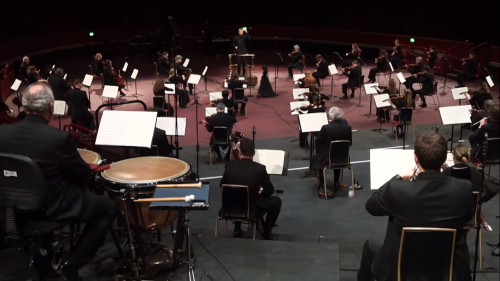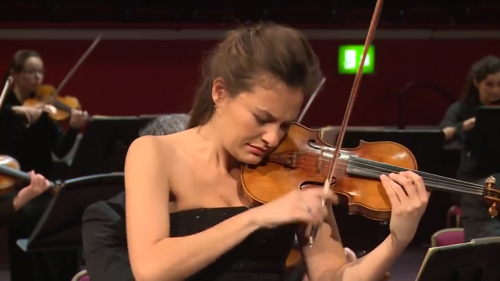 United Kingdom RPO at Home – Tchaikovsky, Beethoven: Nicola Benedetti CBE (violin), Royal Philharmonic Orchestra / Vasily Petrenko (conductor). Performed 3.3.2021 at the Royal Albert Hall, London, it is available (directed and edited by Ali Khan) to stream from 15.3.2021. (JPr)
United Kingdom RPO at Home – Tchaikovsky, Beethoven: Nicola Benedetti CBE (violin), Royal Philharmonic Orchestra / Vasily Petrenko (conductor). Performed 3.3.2021 at the Royal Albert Hall, London, it is available (directed and edited by Ali Khan) to stream from 15.3.2021. (JPr)

Beethoven – King Stephen Overture; Symphony No.5 in C minor, Op.67
Tchaikovsky – Violin Concerto in D major, Op.35
The venerable Royal Albert Hall turned 150 at the end of March and this Royal Philharmonic Orchestra concert was one way I could celebrate that. It was also a haunting reminder of what music-making in the UK might be for most of the rest of this year as a large socially distanced orchestra extended from near the organ to about halfway across where any arena seating would have been. This is where people regularly stand during the BBC Proms but of course this is unlikely to happen again this year even if audiences return for the first time since 2019.
This 80-minute concert had a relaxed introduction from Music Director Designate Vasily Petrenko who said Beethoven’s King Stephen Overture was ‘full of youth, full of optimism. This is a late Beethoven piece, but he had this grand ability to create something youthful, something uplifting, something optimistic. I hope you will enjoy this optimism we need these days.’ King Stephen is the founder of modern Hungary and the overture was first performed in February 1812 to mark the opening of a new large theatre in Pest. It begins in stately fashion and despite some dramatic pauses the music begins to jolly along with a distinct Hungarian flavour; there is spirited playing from the RPO before a timpani roll ushers in the triumphant ending. For me it was very much as if Rossini had reorchestrated the overture to Fidelio!
From Petrenko we heard how Tchaikovsky’s Violin Concerto is one of the most performed in the world nowadays and Nicola Benedetti spoke frankly how ‘there were some particular challenges with this piece that has a lot of moments where the wind section are accompanying the solo violin and as you can see we are extremely far away from one another. So, I’m literally being asked to be the worst chamber musician ever and not listen too much to the sound and just stick with the strings and follow the conductor. But the level of musicianship within the orchestra is so phenomenal it’s just making an unusual circumstance an entire pleasure for me to experience.’ Benedetti also explained how for her the concerto is ‘a little bit like Tchaikovsky losing his mind’ with its ‘craziness’ and ‘it is so repetitive, but in a way that’s sort of insatiable.’

It’s so good not to have any pre-conceived ideas when listening to such a well-known work as Tchaikovsky’s Violin Concerto because I am not certain I have ever heard all of it before! In my naivete I was completely engrossed in where the music was going to take me next in all its romantic lyricism, as well as the results of Benedetti’s technical bravura. The Allegro moderato first movement begins in an understated fashion as the calm before the storm – and the first encounter with the ‘craziness’ Benedetti spoke of – which culminates in the cadenza. Benedetti’s intonation was never harsh, and her playing was particularly enjoyable during the more introverted, melodic moments of the work, though this never upstaged her many extrovert ones. Throughout Benedetti had total mastery of arpeggios, multiple stops, glissandi, large leaps, many trills and dissonances in Tchaikovsky’s score. Here as elsewhere in the concerto Petrenko and the orchestra were the perfect accompanists.
The Canzonetta was like a song with words and had a captivating sultriness before more of the ‘craziness’ and Benedetti’s fingers became a blur as she threw off the acrobatic fretwork with a breath-taking ease. Despite the social distancing Benedetti’s sense of collaboration with different instrumentalists in the orchestra was consummate. Catching the ear and eye – not for the first nor last time in this concert – were Emer McDonough’s flute, John Roberts’s inimitable oboe playing and Katherine Lacy’s clarinet. The jauntiness of the Russian folk themes Tchaikovsky imbues into the final movement (Allegro vivacissimo) once more allowed soloist and orchestra to interact, if rather more playfully this time. Soon the tempo accelerates, there is more repetition, and the music builds and builds promting Benedetti to scamper helter-skelter through the demanding and tightly wrought finale.
Petrenko described Beethoven’s Fifth Symphony as ‘almighty’ and how it had been a ‘special night’ for Beethoven when it was premiered in 1808. Petrenko said ‘it was a night full of Beethoven pieces in a cold hall in December in Vienna. The heating was off, the musicians and everyone were freezing, but they all really appreciated not just Fifth but Sixth Symphony, some of his concertos, soprano aria, many other things. 4½ hours of music by Beethoven and most of it was new music by then. Very quickly the Fifth Symphony became an iconic piece and the masterpiece through which all the other symphonies – not just by Beethoven but by any other composers – were seen.’
Despite what Petrenko seemed to suggest I believe that first Theater an der Wien performance was under-rehearsed (as was the entire concert) and so the symphony was not an immediate success for the composer. Though it began to become known as the ‘masterpiece’ it is recognised as today thanks to a contemporary of the composer, E.T.A. Hoffmann, who wrote a subsequent lengthy – and very influential – review hailing ‘Beethoven’s romanticism … that tears the listener irresistibly away into the wonderful spiritual realm of the infinite.’
I thought the performance given by the outstanding RPO and their incoming music director was remarkable in any circumstances and not least with the musicians so distanced in the empty barnlike Royal Albert Hall. There was no let-up in the recurring rhythm of the opening four-note motif (perhaps the most famous motif in Western music) which underpins the majestic first movement (Allegro con brio). Petrenko’s Beethoven Fifth was fleet-footed with drive and tension which never slackened, whilst at the same time letting all the details of the orchestration come through clearly. The richness and depth of the RPO’s sound convincingly brought out the beauty and rigour of the composer’s musical argument.
We were allowed just a few moments of repose in the second movement (Andante con moto) which is by turns march-like and rhapsodic until the music winds down before a final emphatic statement. Petrenko’s thrusting baton then brought an incredible urgency to the remaining movements. During the third movement the music ramped up to the contrapuntal trio as a contrast to the scherzo which returned for the final time with strings pizzicato. A timpani solo is the innovative transition to the final movement (Allegro) which – again for Beethoven – was oddly joyful and upbeat and had Petrenko and some of his erstwhile stern-faced musicians smiling. All too soon we reached the suitably blazing fortissimo C major tutti heights of the finale reinforced by the RPO’s virtuoso trombones and piccolo. (Some have suggested that this was the first symphony to include these particular instruments, but this is not believed to be true.)
What Petrenko and the RPO deserved was a standing ovation – as Benedetti had earlier – but there was no one there to applaud them, a terribly sad sign of our current benighted times.
Jim Pritchard
For more about the Royal Philharmonic Orchestra click here.
